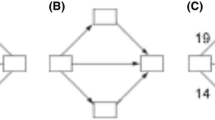Abstract
Following a previous elaboration of the concept of weak individuality and some examples of its instances in ecology and biology, the article focuses on general features of the concept, arguing that in any ontological field individuals are understood on the basis of our knowledge of interactions, through the application of these general formulas for extracting individuals from interactions. Then, the specificities of the individuality in the sense of this weak concept are examined in ecology; I conclude by addressing the differences between ecosystems and organisms as they appear in the viewpoint of such concept.

Similar content being viewed by others
Notes
Actually, I use “concept of weak individuality” and “weak concept of individuality” interchangeably. Even though one could object that they are two different things (e.g., “a communist concept of society” versus “a concept of communist society”), here the differences are not so important, especially because we are not assuming any concept of individuality; so I can just stipulate that “weak individual” is the object of a “weak concept of individuality.”
In the same way, if we use these schemes to individuate cultural entities, we may for example use Dawkinsian memes as entities, assuming many things regarding the entities likely to produce, encode, or transmit memes, but these assumptions as such would not entitle someone to question the fact that there are cultural individuals.
References
Arrigo KR, Sullivan CW, Kremer JN (1991) A bio-optical model of Antarctic sea ice. J Geophys Res 96:10581–10592
Brandon R, Mc Shea D (2011) Biology’s first law. Oxford University Press, New York
Bruno JF, Stachowicz JJ, Bertness MD (2003) Inclusion of facilitation into ecological theory. TREE 18:119–125
Bshari RS, Bronstein JL (2004) Game structures in mutualisms: what can the evidence tell us about the kinds of models we need? Adv Study Behav 34:59–104
Cadenasso ML, Pickett S, Weathers K, Jones C (2003) A framework for a theory of ecological boundaries. Bioscience 53:750–758
Costello E, Stagaman K, Dethlefsen L, et al (2012) The application of ecological theory toward an understanding of the human microbiome. Science 336:1255–1262
Cummins R (1975) Functional analysis. J Philos 72:741–764
Herre EA, Knowlton N, Mueller UG, Rehner S (1999) The evolution of mutualisms: exploring the paths between conflict and cooperation. Trends Ecol Evol 14:49–53
Huneman P (2013) Introduction. In: Huneman (ed) Functions: selected and mechanims. Springer, Dordrecht, pp 1–18
Huneman P (2014) Individuality as a theoretical scheme. I. Formal and material concept of individuality. Biol Theory. doi:10.1007/s13752-014-0192-9
Huss J (2014) Methodology and ontology in microbiome research. Biol Theory. doi:10.1007/s13752-014-0187-6
Jones C, Lawton J, Shachak M (1994) Organisms as ecosystem engineers. Oikos 69:373–386
Khalidi MA (2013) Natural categories and human kinds: classification in the natural and human sciences. Oxford University Press, New York
Kingsland S (1995) Modeling nature. University of Chicago Press, Chicago
Lehmann L (2007) The evolution of trans-generational altruism: kin selection meets niche construction. J Evo Biol 20:181–189
Levins R (1966) The strategy of model building in population biology. Am Sci 54:421–431
Levins R, Lewontin R (1985) The dialectical biologist. Harvard University Press, Cambridge
Michod R (1999) Darwinian dynamics. Oxford University Press, New York
Nagy JD (2004) Competition and natural selection in a mathematical model of cancer. Bull Math Biol 66:663–687
Neander K (1991) Functions as selected effects: the conceptual analysts defense. Philos Sci 58:168–184
Noe R, Hammerstein P (1994) Biological markets: supply and demand determine the effect of partner choice in cooperation, mutualism and mating. Behav Ecol Sociobiol 35:1–11
Odling-Smee J, Laland K, Feldman M (2003) Niche construction: the neglected process in evolution. Princeton University Press, Princeton
Poisot T, Mouquet N, Gravel D (2013) Trophic complementarity drives the biodiversity-ecosystem functioning relationship in food webs. Ecol Lett. doi:10.1111/ele.12118
Queller DC, Strassmann JE. (2009) Beyond society: The evolution of organismality. Philos Trans R Soc Lond B Biol Sci 364:3143–3155
Reeve HK, Hölldobler B. (2007) The emergence of a superorganism through intergroup competition. Proc Natl Acad Sci USA 104:9736–9740
Ricklefs RE (2008) Disintegration of the ecological community. Am Nat 172:741–750
Salmon W (1984) Scientific explanation and the causal structure of the world. Princeton University Press, Princeton
Simpson BB (ed) (1988) Biological diversity in the context of ecosystem structure and function: proposal for an IUBS (International Union of Biological Sciences). Biology International 124:15–17
Sober E, Wilson DS (1998) Unto others: the evolution and osychology of unselfish behavior. Harvard University Press, Cambridge
Sterelny K (2006) Local ecological communities. Philos Sci 73:215–231
van Baalen M (1998) Coevolution of recovery ability and virulence. Proc R Soc Lond B 265:317–325
van Baalen M, Jansen VA (2001) Dangerous liaisons: The ecology of private interest and common good. Oikos 95:211–224
Weisberg M (2006) Robustness analysis. Philos Sci 73:730–742
Woodward J (2003) Making things happen: a theory of causal explanation. Oxford University Press, Oxford
Wright JP, Jones CG (2004) Predicting effects of ecosystem engineers on patch-scale species richness from primary productivity. Ecology 85:2071–2081
Acknowledgments
I warmly thank Minus van Baalen, Sébastien Dutreuil, Arnaud Pocheville, and Livio Riboli-Sasco for insightful comments and critiques on the previous versions of the manuscripts, as well as precious suggestions; along with John Davis, John Dupré, Alexandre Guay, Thomas Pradeu, and the other participants of the workshops (“Stabeco,” December 2010, Paris; “Individuals Across the Sciences,” November 2013, Paris) where early versions of this work have been presented.
Author information
Authors and Affiliations
Corresponding author
Additional information
This paper forms a two-part article with DOI 10.1007/s13752-014-0192-9.
Rights and permissions
About this article
Cite this article
Huneman, P. Individuality as a Theoretical Scheme. II. About the Weak Individuality of Organisms and Ecosystems. Biol Theory 9, 374–381 (2014). https://doi.org/10.1007/s13752-014-0193-8
Received:
Accepted:
Published:
Issue Date:
DOI: https://doi.org/10.1007/s13752-014-0193-8




